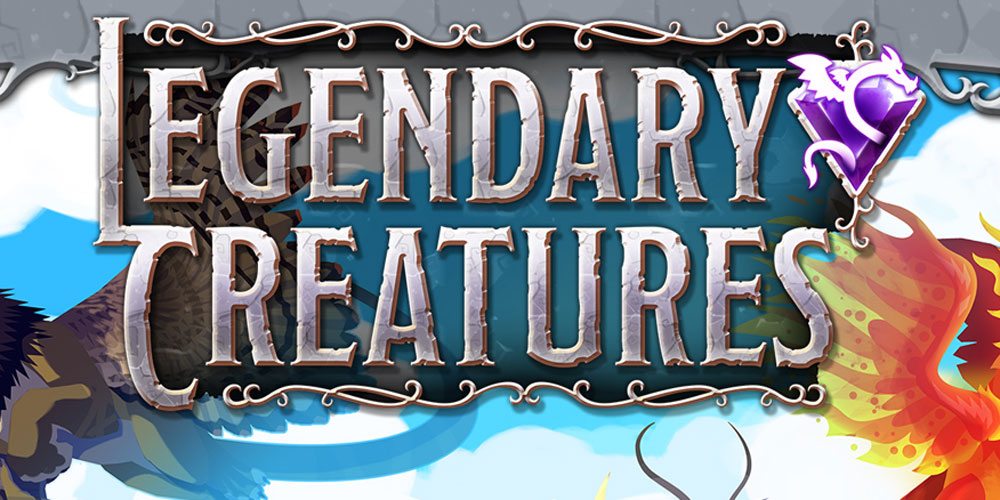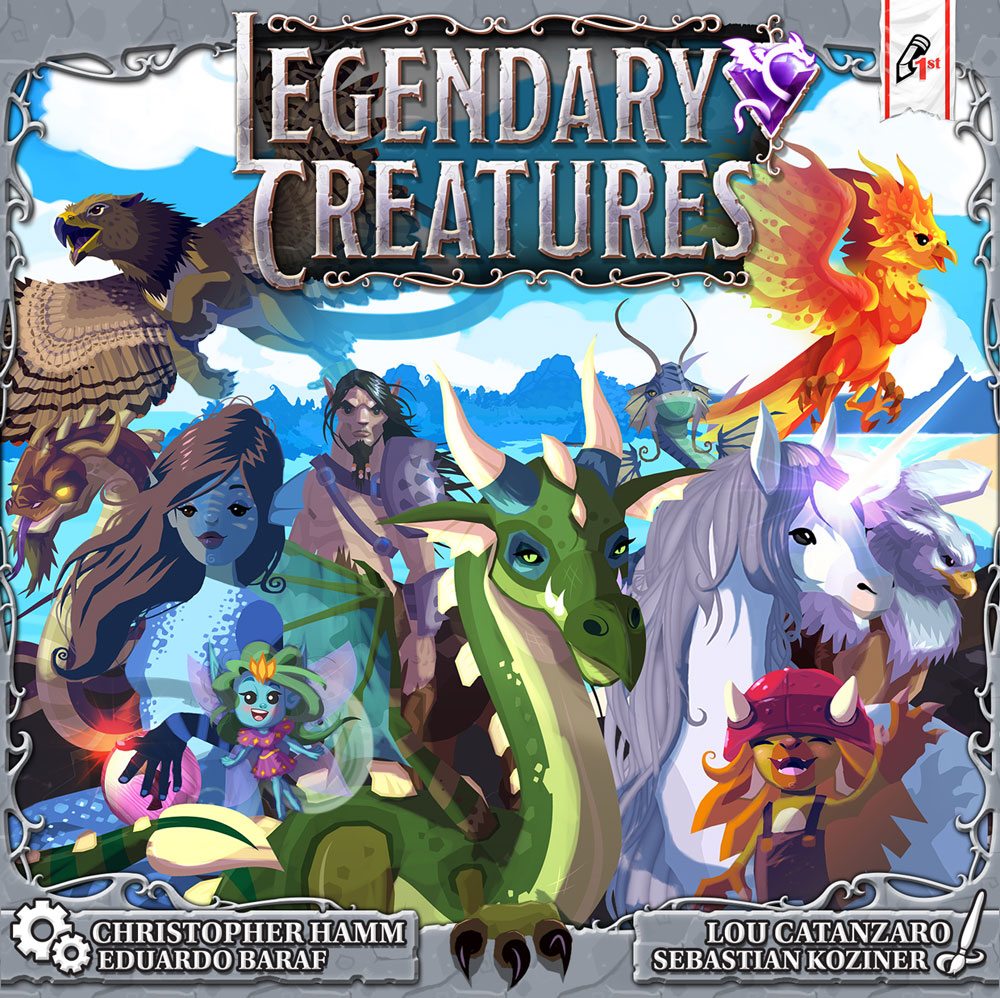The High Council has called for a Trial of Nature’s Grace: the students of the School of Life will take their spells and creatures, and race through the four elemental realms, with the help of Xyleria’s Legendary Creatures!
At a glance: Legendary Creatures is a game from Pencil First Games for 2 to 4 players, ages 13 and up, and takes 30 minutes per player. It’s currently seeking funding on Kickstarter, with a pledge of $39 for a copy of the game. (There are other pledge tiers that include other games from Pencil First.) This is a little heavier than previous titles from Pencil First, but I have played with (experienced) kids as young as 8, but they have to have patience for a longer game—though there are options for playing a shorter version.
New to Kickstarter? Check out our crowdfunding primer, and visit our Kickstarter curated page for more projects we love.
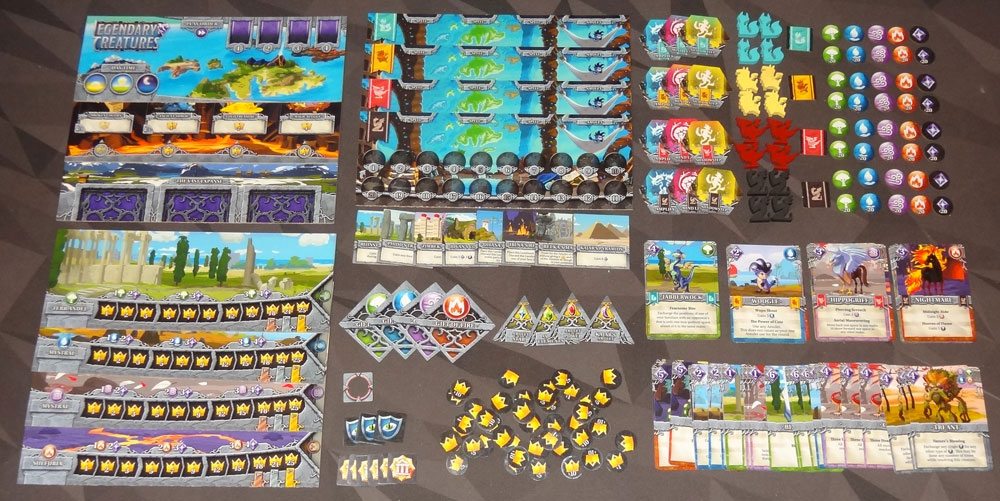
Components
Note: my review is based on a pre-production prototype, so the components shown in my photos may not be final and are subject to change, and do not reflect final component quality.
- World View board
- Expedition board
- Vast Expanse board
- 4 Realm boards
- 4 sets of player components, each containing:
- Player board
- Player token
- 4 Familiar meeples
- 3 Spells
- 8 Orb tokens
- 2 Magic tokens
- 12 Creature Cards
- 36 Wild Creature cards (4 each in 9 types)
- 69 Renown tokens (in 1, 5, and 10 values)
- Day Mark token
- 8 Expedition tokens
- 4 Shield tokens
- 4 Amulets
- 4 Gifts
- 12 Landmarks

Most of the art and design for the game is already finished, and I really like the way it looks. The illustrations are by Lou Catanzaro and the graphic design is by Sebastian Koziner. The illustration style is a little cartoony, setting it apart from the realistic painted look of many fantasy games, but it’s also not comic-book style. The icons for the various elements and items also have a nice uniform look that ties all the various boards and cards together.
The Familiar meeples (also on the player banners) are really cute—I’m particularly fond of the yellow familiar, which appears to be a winged alpaca.
As you can see from the photo, there’s a lot of stuff to this game, but once you get things laid out, it makes sense for the most part and becomes fairly easy to follow.
There were a couple things I mentioned to Ed Baraf (the publisher and one of the game designers) that I thought could be tweaked a little—for instance, it seemed like the World View board and the Vast Expanse board could be combined, both to get rid of one component and to take up a little less space on the table. Also, the resource tokens (Orbs and Magic) for each player could be double-sided, so that there’s a “20+” side rather than two separate tokens. I’m not sure which, if any, of my suggestions will make it into the final game.
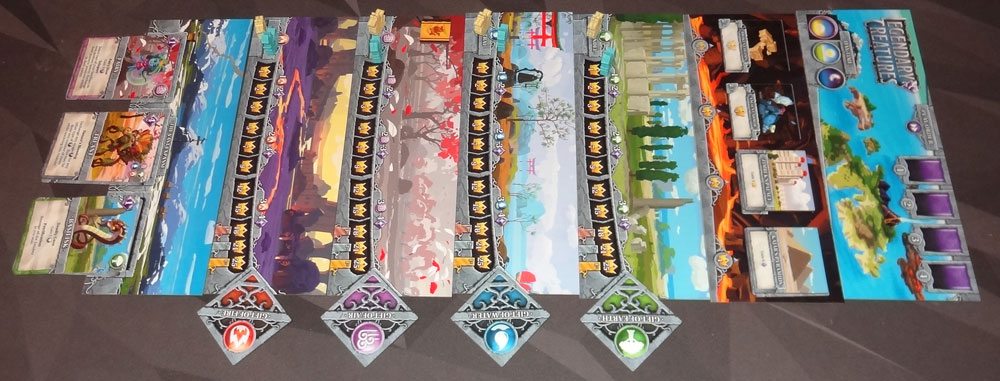
How to Play
The object of the game is to earn the most renown, which comes from your positions in the four realms, expeditions, and creature abilities.
To set up, lay out the boards in the center of the table: World View, Expedition, 4 Realms, and Vast Expanse. The Landmarks are shuffled, and two are placed on each of the Expedition board spaces (leaving some spaces empty if there are fewer than 4 players). The four Gifts are set next to their corresponding Realm boards. Renown, expedition, and shield tokens are placed in a supply near the board. The Day Mark token is placed on the sunrise spot on the World View board.
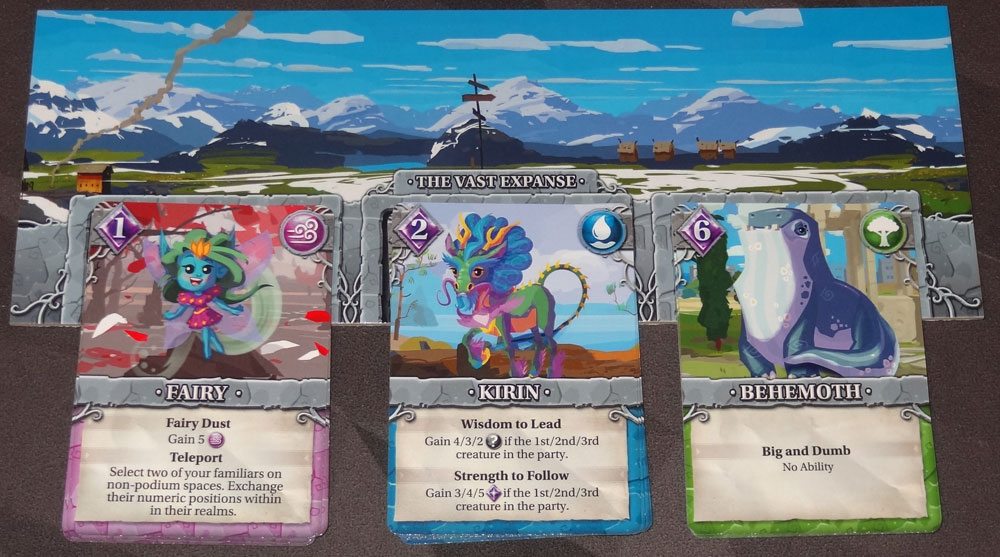
(Prototype shown) Photo: Jonathan H. Liu
The Wild Creatures are set up face-down in the Vast Expanse board so that there are 9 different creature types, 3 in each slot. The top three creature types are turned face up. (The number of each creature used is equal to the number of players.) This portion of the setup can be a little tedious, counting out all the creatures, sorting them into types, and so on. My solution is to take one of each creature, shuffle and deal three to each space. Then, when they’re revealed, add matching creatures from the deck until you have one per player of each type.
Give each player their set of player components. The Familiar meeples are placed on the four realms at the starting podium. Each player gets a random Amulet. (For 3 players, leave out the Amulet of the Stars; for 2 players, give each player 2 Amulets.) Each player shuffles their deck of 12 Creature cards to form a deck. Use the Orb and Magic tokens on the player board to indicate that you start with 1 of each resource. Each player also starts with 5 renown tokens.
The game takes place over the course of three “days,” each of which has three rounds (morning, midday, night). At the end of each day, there’s an additional phase that takes place, including the Expeditions.
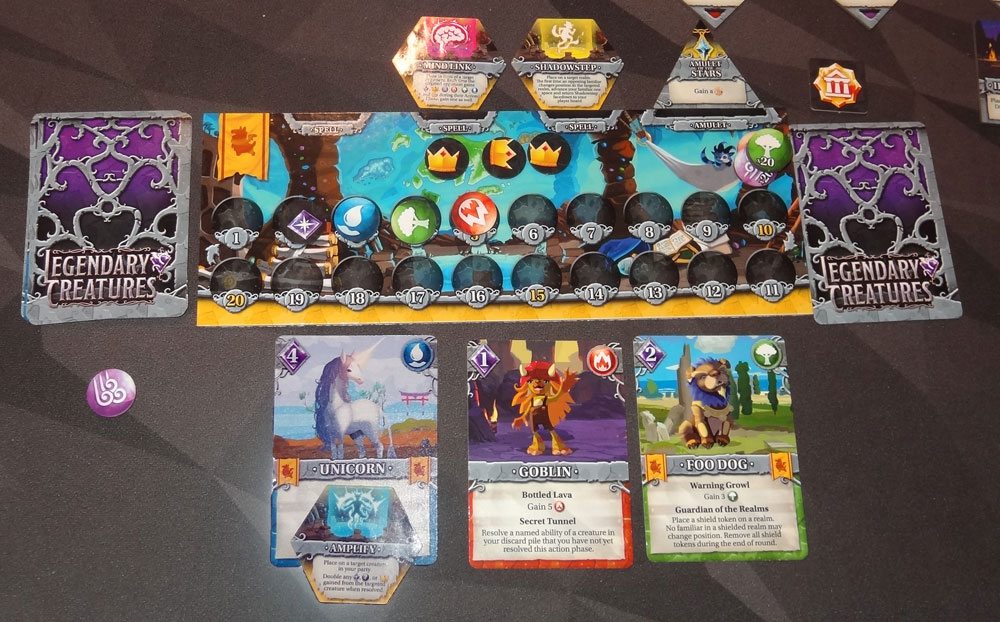
To start a round, each player draws 4 cards from their deck, and then places three of them face-down to form a party, and the fourth one next to their player board for the Expedition. When everyone has chosen, they reveal their parties. The turn order for the round is determined by the value of the first creature in each party, with the highest value going first and lowest value going last. (Ties are always broken by whoever has Kajan’s Amulet and then going clockwise.) Place the player banners at the top of the World View board to show initiative order.

Mind Link, and Shadowstep. (Prototype shown) Photo: Jonathan H. Liu
In turn order, each player has an opportunity to cast spells. Amplify is played on one of the creatures in your party, and doubles any resources or renown gained from that creature. Mind Link is played on one of your opponents, and each time that opponent gains something, you get 1 of that as well. Shadowstep is played on one of the four realms—as soon as an opponent changes position in that realm, you immediately get to move one space, and then take your Shadowstep spell back. Each spell may only be cast once per day—they will refresh at the end of the day.

In turn order, each player will activate their creature party. First, you “invoke” one of the four realms by placing your banner on it—you may only move in the realm that you invoked, and your creatures that match that realm will give you a bonus when you resolve them this turn—whatever you gain (resources or renown), you get 1 extra. Then, you resolve each of your creatures from left to right. Each creature may generate Magic, use one of their printed abilities, or be exchanged for a Wild Creature. When generating Magic, simply gain the number of Magic shown in the purple diamond on the card. To use an ability, simply follow the instructions on the card. Finally, to exchange a creature, remove it from the game and take any of the face-up creatures from the Vast Expanse board and put it in its place, and then resolve the new creature. You may only befriend a new Wild Creature once per round.
At any time during your turn, you may pay resources to move along the track in the realm you invoked. It will cost you Orbs of the matching element and Magic, and the cost increases as you move farther along the track. You may spend any 2 Orbs for 1 Orb of another element. Any number of familiars can be on the track spaces, but the last space has podiums for 1st, 2nd, and 3rd place and only one player can be on each of these spots.

During your turn, you may also activate your Amulet once. Kajar’s Amulet has a passive effect of winning ties, but the other three give Magic, Orbs, or Expedition tokens. You may also swap an Amulet with another player if you pay them 1 renown, but only if you have not activated your Amulet yet.
Once all the players have activated their creatures, the round is over. Everyone retrieves their spells (face-down, since they are spent) and discards their party creatures. Then, the Gifts are assigned: the player who is the furthest along the track for each Realm is awarded that Gift. You aren’t eligible for a Gift if you’re still on the starting podium or if you’ve reached the ending podium.
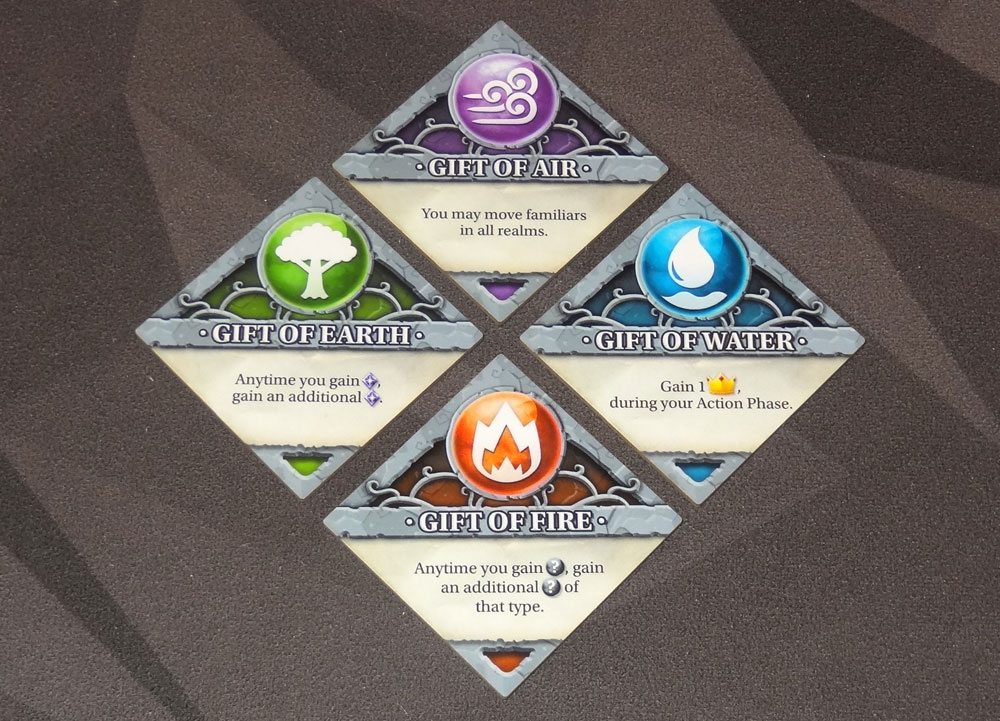
Each of the Gifts has its own effect:
- Gift of Air: You may move in all Realms, not just the invoked Realm.
- Gift of Earth: Every time you gain Magic, you get an additional Magic.
- Gift of Fire: Every time you gain Orbs, you gain an additional Orb.
- Gift of Water: Gain 1 renown during your action phase.
Then, advance the Day Mark token for the next round.

(Prototype shown) Photo: Jonathan H. Liu
After the “night” round, the day ends, and the Expedition takes place. Players reveal the three creatures placed into their Expedition stack, and add up the Magic values. Expedition tokens are worth +2 each. The player with the highest value chooses a location first, gaining the effects of that location and the renown listed below. Some locations have immediate effects, and some are kept and can be discarded for an effect later. On the final day, there are no location tiles; instead, the renown value is doubled (as printed on the Expedition board).
Also, at the end of the day, any remaining face-up creatures in the Vast Expanse are removed from the game, and the next set of creatures is revealed. Then, everyone refreshes all of their spells, turning them face-up. Reshuffle all of your creatures (both from the parties and the Expedition) to create a new deck for the next day.
The game ends after the third day. You gain renown for your positions on the tracks in the four Realms, plus any renown tokens you’ve earned, plus 1 renown for every 5 combined Orbs and Magic. The highest score wins, with ties broken by Kajar’s Amulet.
The game includes two variant rules: for a shorter game, play 2 days instead of 3. For advanced play, allow players to mulligan if they don’t like their hand of 4 cards: pay 1 renown to the supply, draw 4 new cards, and then shuffle the original hand back into the deck. You may do this as many times as you wish, as long as you can pay the renown (and your deck is not empty).

The Verdict
Legendary Creatures has some light deck-building aspects and resource management, but at its heart it is a race game—everyone is racing to get to the podiums first, and nearly everything you do is working toward that goal. But there’s some cool stuff going on that affects how the races play out. I’ve played the game with 2, 3, and 4 players, and I think it works well with all player counts, but I particularly like the 4-player game the most simply because there’s more interaction and potential for spoiled plans.
Now, I’ll tell you up front: there’s a lot going on in this game, and it’s a little bit of a departure for Pencil First Games, which has had lighter, casual games so far. If you have players who are prone to analysis paralysis, the game can drag a bit, simply because there are so many options. I like the way everything fits together, but it can definitely be intimidating for some players. I do recommend trying the 2-day shorter game for a first play-through, just to ease into it a little more.
Unlike many deck-building games, your starting cards aren’t weak. You can only replace one card per round (a total of 9 over the course of the game), so it’s unlike traditional deck-building. It’s maybe more like deck-evolution, particularly since you replace cards instead of adding them. In one game I played, the second-place player only replaced a single creature, so the starting creatures can be quite effective when used properly.
That, of course, is a key part of the game: learning what all the creatures do and how to combine them in interesting ways. You’ll need to use some creatures to get Magic, of course—usually, the higher the Magic value of a creature, the lower its Orb value (if any). But many of the creatures have two abilities, so you’ll have to choose between them when you resolve them. The Foo Dog can give you Earth Orbs, but you can also use it to place a shield token on a Realm, preventing everyone there from moving for the rest of the round.
I really like the mix of abilities present in the game. Some creatures will let you activate other creature abilities in your discard pile or in the Vast Expanse. There are ways to manipulate your position in the Realms—swapping the position of two of your own Familiars in different realms, stepping backward in one Realm to move forward in another, or even trading places with another player who is one step ahead of you. These abilities make it tricky to know for sure how big your lead is on another player until you actually reach the podium and your position is locked in.
There’s also an interesting flow to the game: you want to get an early lead when you can, because you’ll be eligible for the Gifts, which are quite powerful. But once you get to the podium, you’ll lose the Gift, so you don’t always want to hit the end unless there’s somebody on your tail. It gives you an advantage while you’re still in the running, but then works like a catch-up mechanic once you’ve arrived.
Once you reach a podium, you really don’t need any Orbs of that element any more. They’re worth a fraction of a point at the end of the game, but you really want to focus on the other Realms. When you’re exchanging creatures with the Vast Expanse, it’s important to consider not only their abilities, but also their affinities, so you can take advantage of bonus resources. If you end up with no way to get Fire Orbs because you traded all of your Fire creatures for Earth creatures, then you’re going to be at a big disadvantage there.
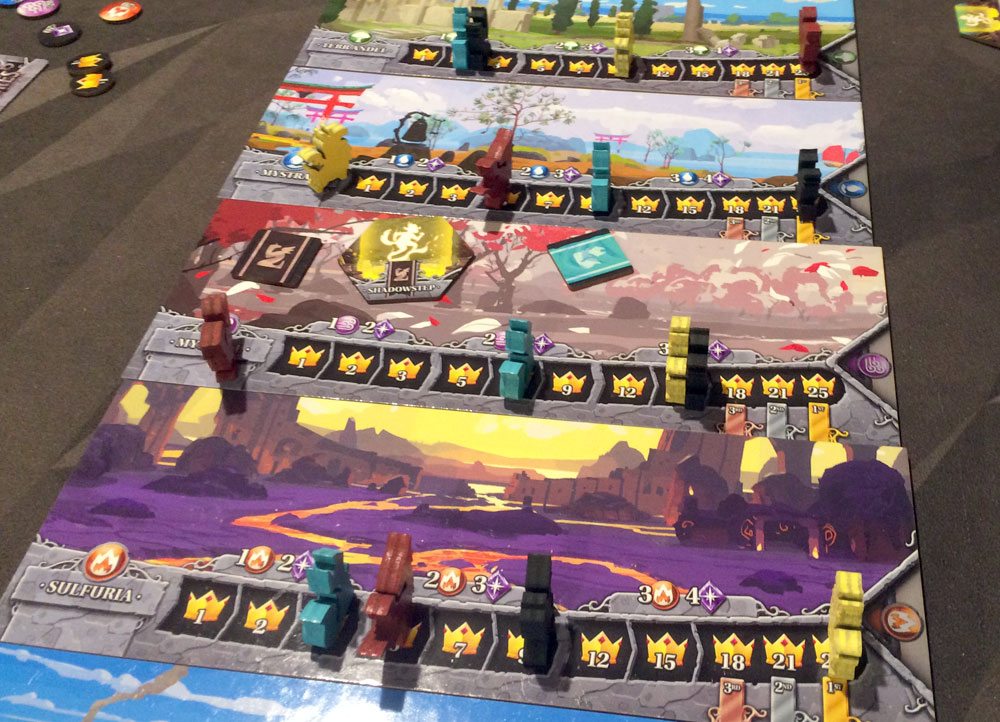
I like that you must choose your party and cast spells before anyone has activated their creatures—if you’re not first in initiative order, then somebody else might take an action that messes up your plans, but you’re stuck with the creatures you’ve already played (with the exception of trading one in at the Vast Expanse). It can require some quick rethinking to use what you have.
Even though the biggest point values come from winning the race, there are a few other sources of renown. Getting first choice for an Expedition can give you a good location power, but it can also be worth some points (particularly on the last round). Some of the creatures award points as well: often it didn’t seem like a great strategy to me, but if you’re able to Amplify that Creature and get an affinity bonus, that’s not always a bad idea.
I also like the ability to swap Amulets with other players. Sometimes you really just need that extra Magic to move one more space; sometimes you really want to guarantee that you’re going to win a tie. Either way, you can get the Amulet you need, but it will cost you a point. The other trick, of course, is that unless you’re the last player in turn order, somebody else could still take it from you before the end of the round.
The initiative order isn’t necessarily that important early in the game, when everyone is still near the starting line, but it does become pretty important later. Sometimes you want to go last, because then you can reap the benefits of your Mind Link spell, or see what other players have done and adjust your strategy accordingly. If you’re close to getting a Gift or two, knowing exactly how far you need to travel can be a huge benefit. But if there are a couple of people close to the finish line, you can’t risk going too late because it can cost you points. But since your creatures must be activated in the order you play them, you can’t always just put your highest number up front, because you may need to activate a different ability first.
All in all, Legendary Creatures gives you a lot of interesting choices to make and room for strategy. Because of the Gifts, the four realms aren’t exactly equivalent, and racing ahead in one of them will give you different advantages than another. You’ll want to figure out how best to use your creatures, when to trade them for new creatures, and which to send on Expedition. If you like mythical creatures and card combinations, check out Legendary Creatures on Kickstarter!
Click here for a full index of our tabletop game reviews.
Disclosure: I was loaned a prototype for this review, but I had to send it back. I’m hoping this funds so that I can play it some more!
